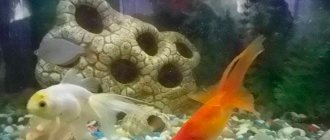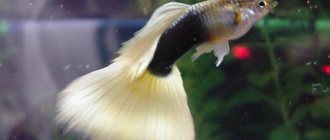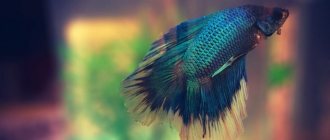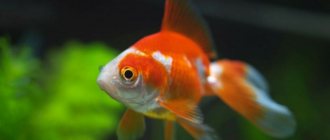Quickly navigate to the article
- 1 Reasons why a fish can swim with its belly up
- 2 Nutritional features
- 3 Treatment; how to fix the situation 3.1 Other interesting articles
A goldfish is the decoration of any aquarium, the eye is involuntarily drawn to it, you want to watch its smooth movements endlessly, but... what to do if it suddenly floated to the surface of the water and turned upside down, because this is considered a formidable sign, a sign of a serious physiological disorder? The goldfish is not only a very beautiful aquarium fish, but also very sensitive to the slightest changes in living conditions: water temperature, its quality, chemical composition, and, especially, nutrition. If, for example, a swordtail or a gourami can more or less adapt to its habitat, in the case where it does not differ much from the natural environment, then ideal conditions must be created for the goldfish. Only then will she live a long, fulfilling life, delighting the eyes of her beholders. Reasons why a goldfish turns over
Symptoms
Fish gained the ability to move in the aquatic environment in the process of evolution due to the development of various devices - a swim bladder, a streamlined body shape, a special musculoskeletal system (fins connected to muscles). The swim bladder holds the fish at the desired depth, the fins stabilize the position of the body, and the brain coordinates actions.
A healthy goldfish can swim in a horizontal or vertical plane throughout the aquarium, turn around, briefly float to the surface, or dive.
Symptoms of an unhealthy state of fish with impaired coordination of movement:
- tries to surface with effort, but goes to the bottom, the abdominal part is swollen;
- often breathes at the surface on its side or like a float in an inverted position;
- caudal fin above head level;
- lies in the bottom of the aquarium on its side or back;
- hangs in a vertical position (stands on the head);
- tries to counteract the abnormal posture and assume a normal body position.
The painful condition is often accompanied by apathy, mucous or bloody discharge from the anus, and damage to the integument.
Attention!
Even with unhealthy symptoms, goldfish can maintain an appetite and continue to eat. This is not a reason to consider the fish’s condition satisfactory and refuse treatment.
Goldfish are very beautiful, graceful and also unpretentious inhabitants of home aquariums
Eyes bulging
Bulging eyes and the appearance of a whitish coating on the eyes accompanies the following diseases:
Examine the skin and fins, observe the behavior of the inhabitants of the aquarium. Check water parameters. Changes in one eye usually indicate injury.
Possible reasons
It is important to establish the cause in a timely manner. Sometimes neoplasms, congenital or genetic diseases lead to such behavior in a pet.
The anatomical features of a goldfish do not always allow it to swim in a normal position. Loss of balance is typical for short-bodied individuals. The interference of selection in nature dooms such breeds to constant existence in an abnormal position. Short-bodied fish can roll over only when feeding. The rest of the time they swim with their belly up.
For long-bodied species, such a natural deviation is unusual. Most often, a lack of coordination lies in improper care and maintenance of aquarium inhabitants.
| The relationship between errors in care and the development of pathological conditions in goldfish | |
| Incorrect content | Provoked diseases |
| overfeeding, unbalanced diet | gas formation, inflammatory processes, obesity, enlargement of internal organs |
| low-quality live food, adding sick animals to the aquarium | parasitic, infectious, bacterial diseases |
| poor aeration, high biological load, irregular water changes | hypoxia (oxygen starvation), toxic poisoning |
| intensive aeration, abundant vegetation with continuous and bright light | gas embolism (excess oxygen) |
| wrong soil | foreign body ingestion |
When under extreme stress, a goldfish may swim belly up in a daze. If there is no constant source of irritation in the aquarium, then such a dysfunction is short-term, disappears after 5-10 minutes and does not require treatment.
The fish swims belly up on the surface of the water
Fronder
It is dangerous to immediately rush to treat fish with drugs. Without knowing the effect of the drug, you can harm other fish. Different drugs are intended for different diseases. Methylene blue is a synthetic blue dye. The solution is used to treat fungal diseases of aquarium fish, as well as to prevent stress that occurs during transplantation and transportation of fish. It is an effective remedy against blood diseases associated with fish poisoning by cyanide and nitrates. First we need to find out the reason. There may be no cause for great concern. If your dolphin is blue, then they grow up to 20 cm. And if your aquarium is not very large, it could simply die from overcrowding. If the fish turns over on its belly, but is still breathing, it means it is dying. It is important to identify the cause. The life of other fish in the aquarium depends on this. There can be many reasons. Overpopulation, overfeeding, obesity of fish, infectious diseases, and maybe aging of a particular fish. Examine the fish. Are the fins pressed or protruding, the mouth open or closed, are there any external color changes or other external changes on the body described below. Nothing can help your fish, but look at the other fish. Are they standing, swaying near the flow of water from the filter, are they itching against the stones, do other fish have folded or compressed fins and tails. Are some fish swimming in the corner, sluggish? Externally inspect each fish to see if there are any small dots on them (like semolina or like flour), if there is any cottony coating on the fins, skin or scales, various swellings, hemorrhages, ulcers. Or a milky white coating of mucus on the entire body or individual parts of the fish. Do the fish have swollen bellies or reddened anuses? Treatment depends on different symptoms. Sometimes the death of one fish occurs due to conditions that are unsuitable for it or due to changed conditions in the aquarium that have become unsuitable for it. When overcrowded, the weakest fish often die, while the rest live normally. There are bacterial diseases that are not noticeable to the eye, and weakened fish suffer from them. Other, stronger fish are not affected by the disease. If your fish have any changes in behavior or mood (fearfulness, loss of appetite, aggressiveness, apathy, throwing, circling in place, swimming on their side, tail or head up), then these are signs of trouble in the aquarium or disease. There may be an increase or decrease in pH in the water, a decrease or increase in water temperature, even the influence of weather (pressure changes), a decrease or excessive increase in the oxygen supply. If you can, write a clarification in the comments. It may be possible to solve the problem and prevent further spread of the infection if there is one in the aquarium. If the rest of the fish are fine, they are not obese, etc., and there are not so many of your fish (there is no overpopulation), then the fish could die for its own reasons - stress, old age, a non-contagious internal disease and conditions that are unsuitable for it at the moment .
What to do and how to treat
Aquarium inhabitants whose health condition is of concern are immediately isolated. After this, the fish should be carefully examined for external signs of disease. Avoid ingestion of a foreign body.
Main methods of treatment:
- Viral or bacterial infections that cause inflammation of the swim bladder are treated with rimantadine (10 g of powder diluted in 500 ml of water, then use only a solution of 1 ml per 10 liters of water) or chloramphenicol (tablet for 20-30 liters of water, daily for 3-5 days).
- Mild forms of intestinal amebiasia are treated with hydrogen peroxide (10 ml per 25 l of water, daily); for severe forms, furazolidone (50 mg per 10–15 l) and doxycycline (40 mg per 10–15 l) are used.
- Some types of harmless forms of myxosporidiosis are treated mechanically. White nodes are carefully removed from the integument. Another type of invasion occurs against the background of open ulcerations with damage to muscles and internal organs and leaves practically no chance for the fish to live. In unadvanced cases, ultraviolet irradiation may help. The most serious disease, hoferellosis, cannot be treated.
- Glucose is incurable. To prevent infection in fish that have been in contact with sick people, use rivanol (0.35 g per 10 liters of water).
- Ichthyophonosis also cannot be treated; the progression of the pathology can only be restrained by using nystatin.
- Dropsy can be cured only in the early stages at the stage of secretion of mucous excrement. The fish is transplanted into a tank with a solution of magnesium sulfate (1–2 teaspoons per 40 liters of water) and antibacterial therapy with tetracycline (tablet per 25 liters of water) or chloromycetin (8 mg per 1 water) is started. It is best to use special food with antibiotics. When the fish swims with a swollen belly, the treatment will no longer be effective.
Errors in nutrition are treated by fasting. For the first two days, feeding is excluded, then you can start giving only plant foods. This will help the fish clear the tract and return to normal.
Attention!
With obesity, the liver most often suffers and in advanced cases it is impossible to cure your pet.
Goldfish should be treated by qualified personnel
The goldfish swims with its belly bloated. how to save her?
Vera N
If not permanently yet, then you can save it. She's probably on dry food. Start feeding natural food and everything will go back to normal. I’ve been feeding my goldies this way for a long time now and I don’t notice these changelings anymore. Fresh scalded nettle, fresh dill, fresh cucumber will help first of all. Boiled buckwheat (after washing again), boiled egg (white), boiled shrimp, maybe boiled chicken breast, boiled peas, fresh lettuce, etc. raspberries live and frozen.
Prevention
Proper care and maintenance of goldfish is the main preventive measure. This will help exclude most acquired pathologies.
| Diseases | Prevention |
| gas formation, inflammatory processes of the intestinal tract, obesity | balance the diet - 70% plant foods, 30% protein |
| avoid overfeeding, arrange fasting days once a week | |
| Pre-soak dry food so that it does not swell in the intestines | |
| parasitic, infectious, bacterial diseases | deep freeze live food |
| add only healthy individuals to the aquarium after quarantine isolation | |
| hypoxia, toxic poisoning | provide fish with good aeration and filtration |
| select a tank of suitable volume to eliminate biological load | |
| control the physical parameters of water | |
| weekly siphon the bottom and replace 1/3 of the water volume | |
| gas embolism | normalize aeration |
| reduce the number of aquacultures | |
| foreign body in the intestine | exclude fine soil and other decorative elements that fish can swallow |
Particular attention should be paid to nutrition. It is recommended to use specialized combined feeds that are designed for this breed.
Red spots
Causes of red spots:
Treatment
First of all, you need to examine the problem individual and pay attention to whether it has sores, rashes, or white spots on its body. These signs indicate infection by viruses, fungi, and parasites. Such a fish needs to be removed so that the rest of the aquarium inhabitants do not become infected.
The next step is fasting for 3 days. After fasting, she should be given peeled and mashed boiled peas to eat. You can take frozen peas and boil for a minute. Peas are given for 2-3 days, one pea per day. Peas help cleanse the intestines. If the fish is swimming upside down or on its side, and it is difficult for it to take food due to its position in the water, then you need to help by bringing the food closer to the mouth.
During a fasting diet, the water temperature should be quite warm: 26-28 degrees. Then it will be easier for the fish to float up. To do this, you can also reduce the water level.
If you suspect a swim bladder injury, you will have to wait until the injury heals on its own. At this time, the wounded fish must be created comfortable conditions and protected from its relatives.
If these measures do not help, then drug treatment is needed. In case of infection, an antibiotic is used, for example kanamycin or chloramphenicol. If it is a fungal disease, then it is treated with methylene blue. You need to show the sick animal to a veterinarian or consult by phone.











